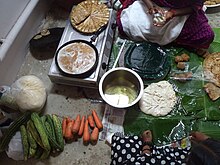Puran poli
This articleneeds additional citations forverification.(August 2012) |
 | |
| Alternative names | Bobbattu, obbattu, holige, ubbatti, vedmi, poli, puranachi poli, god poli, boli, pappu bakshalu, bakshalu, oliga, abatulu.[citation needed] |
|---|---|
| Place of origin | India |
| Region or state | Maharashtra,Andhra Pradesh,Karnataka,Gujarat,Goa,Telangana,KeralaandTamil Nadu |
| Serving temperature | Hot or Cold |
| Main ingredients | Wheat flour, sugar, chana, ghee, jaggery |



Puran poliis an Indian sweetflatbreadthat is popular inSouth Indiaand the state ofMaharashtra.It is also known asPuran puri,Holige,Obbattu,Bobbattlu,Poley,Bakshamulu,andBoli.
Names[edit]
The various names for the flatbread includepuran puri(પુરણ પુરી) orvedmiinGujarati,bobbattluorbakshamoroligainTelugu,Andhra PradeshholigeorobbattuinKannada,puran poli(पुरणपोळी) inMarathi,payasabollior simply bolli inMalayalam,BoliinTamil,bhakshaluorpoleorpolaeinTelugu,Telanganaandubbattior simplypoliinKonkani.
History[edit]
There is a reference to this dish in the Sanskrit encyclopediaManasōllāsain the 12th century written byKing SomeshvarainKarnataka.[1]
Its recipe (asbakshyam) is mentioned inManucharitra,a 14th-century Telugu encyclopaedia compiled byAllasani Peddannahailing from present-day Andhra Pradesh.[1] Bhavaprakash and Bhaishajya Ratnavali written by Govind Dasa state the recipe while explaining it as part of Ayurvedic preparations.[2]
Ingredients[edit]
Holige is made fromsenaga pappu,plain flour (wheat flour),maida,jaggeryorcane sugar,cardamompowder and/ornutmegpowder, cinnamon powder,gheeand water. In Maharashtra,Maida,Jaggery,nutmegpowder, Chana Dal/Bengal gram,Ghee,andcardamompowder is used. Sometimes,pigeon peais used inGujarat.It is commonly used in the state ofKarnatakaand Tamil Nadu as well. In Andhra Pradesh and other places,pesara pappu,chickpea(senaga pappu) or a mix is used. Other ingredients that may or may not be used are: nuts, dates, and turmeric powder.[3][4]
Nutritional value[edit]
The predominant ingredients are chana, plain flour, jaggery or sugar.
1.Chana:It is a variant of chickpea. It providesfiber,is a major source ofprotein,may help reducecholesteroland also containszinc,folateandcalcium.[5]Toor dal can be used in place of chana dal and it has similar properties as of chana dal.
2.Plain flour,jaggeryorsugar:These are the major sources ofcarbohydrates.While plain flour adds complex carbohydrates, jaggery and sugar are simple carbohydrates.
Regional variants[edit]
This sectionneeds additional citations forverification.(September 2020) |
The method of preparation varies from place to place. There are many varieties of Obbattu including peanut, sugar, coconut, sesame and groundnut flavours. Sometimes grated coconut is added in Konkan, Maharashtra.Coconut palmjaggerymay be used. Similarly, a mix of sugar and jaggery can be used as a sweetening agent. Normallynutmegis used as a flavouring along the coast which is replaced bycardamomelsewhere or sometimes both are used. Methods of rolling the stuffed dough also differ. It can be rolled using rice flour which makes the rolling very convenient. In some recipes flour is not used at all; oil or ghee is used to roll it into a flatbread instead. The rolled bread can be roasted with or without any ghee or oil, which sometimes is smeared after it's completely cooked. In some places, all-purpose flour dough is used after adding a pinch of turmeric which gives it a traditional yellow color. The dish is produced using a sweet filling inside flour dough. This is then rolled out and cooked on a hot griddle, usually with ghee.[6]
The size and thickness of puran puri also vary greatly. In Gujarat where the stuffing used is toor dal, it is smaller in size and thicker, whereas in holige with coconut stuffing it is larger in size and thinner.
Maharashtra[edit]
It is the special dish of Maharashtra which is prepared on every occasion at every house, especially during festivals such asGudhi Padwa,Akshaya Tritiya,Ganesh Chaturthiand Holi. It is eaten with Basundi,Aamras,Kadhi, Amti, etc. In Maharashtra, Puran Poli is eaten with a variant of Amti (flavored sour curry) known asKatachi Amtiwhich is prepared with the remaining water of cooked Chana Dal used to make Puran Poli. Mainly jaggery is used in puran poli for sweetness. It is eaten with Vada (Bhaji) – a pakora made of all lentils. In some regions of Maharashtra, Puran Poli is served with a dollop of ghee on top, which enhances its flavor and richness. The texture and taste of Puran Poli can vary from region to region, with some areas making it thinner and crispier, while others make it thicker and softer. The process of making Puran Poli can also differ slightly depending on the region, with some using a rolling pin to flatten the dough while others use their hands to shape it. The North-Maharashtra (Khandesh) region makes it using hand and calls itKhapar chi Puran Polior simplyMandewhich is huge in size and difficult to make.
Andhra Pradesh[edit]
It is popularly calledbobbattuand served on major festive and other occasions. It is one of the sweets ofCoastal Andhra.The stuff used inside the bobbattu varies according to the region. It is served hot and eaten by applying a layer of ghee to it. Rava bobbattu is another variant of bobbattu. It is calledobattuin Rayalaseema region of Andhra Pradesh and poli in northeast Andhra Pradesh.
Karnataka[edit]
It is a special dish served in the state of Karnataka on all occasions, especially during Yugadi (ಯುಗಾದಿ). Different varieties of holige are served in various parts of Karnataka and the most common is the one prepared with yellow gram and sugar or jaggery and obbattu is also prepared using coconut and sugar as the ingredients.
Tamil Nadu and Kerala[edit]
Opputtu in Tamil Nadu and payasaboli in Kerala is a golden-yellow sweet pancake from Tamil Nadu and Kerala. It is eaten during a traditionalsadhyaalong withpayasam.Several varieties of opputtu are prepared, including thenga (coconut) boli andsharkara(brown sugar).
Opputtu is eaten mostly after lunch or as an evening snack. It is popularly sold in trains by hawkers.
Trivandrum boli is also a variety from Kerala.
Varieties of opputtu are available throughout theDeccanstates.
See also[edit]
References[edit]
- ^abK.T. Achaya (2003).The Story of Our Food.Universities Press. p. 85.ISBN978-81-7371-293-7.
- ^मनोहर, विष्णू."पुरणपोळी".maharashtratimes.Retrieved19 March2021.
- ^"Puran Poli".Dassana's Veg Recipes.9 September 2012.
- ^"How to make Puran Poli".Sanjeev Kapoor Recipes.Retrieved16 August2020.
- ^S, Pooja (6 November 2014)."Healthy And Nutritious Tips: Health Benefits of Chana Dal".Healthy And Nutritious Tips.Retrieved17 November2017.
- ^"Bele Holige / Obbattu".Kannada Cuisine. Archived fromthe originalon 12 October 2018.Retrieved27 December2012.




